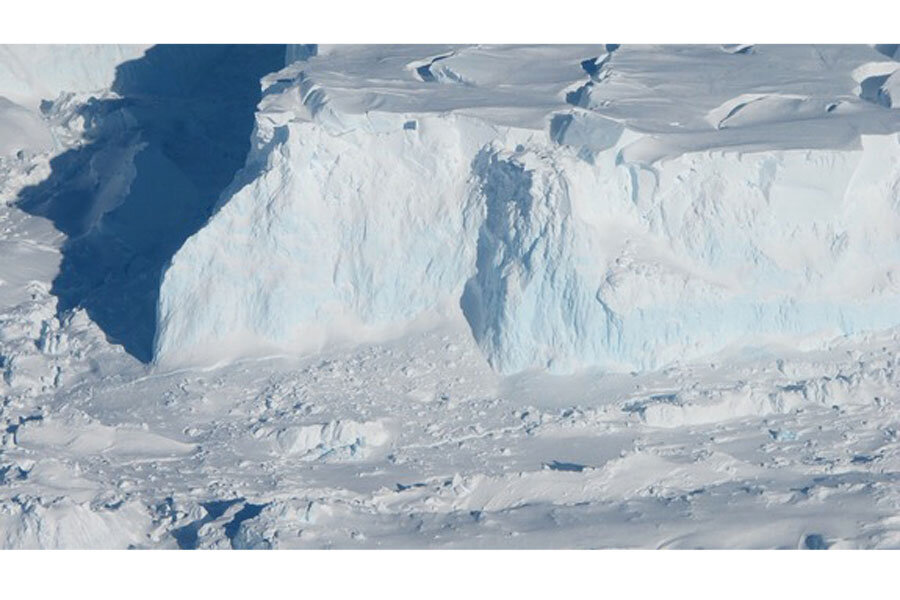Subglacial volcanoes melting West Antarctic Ice sheet, say scientists
Loading...
Antarctica is a land of ice. But dive below the West Antarctic Ice Sheet, and you'll find fire as well, in the form of subglacial volcanoes.
Now, a new study finds that these subglacial volcanoes and other geothermal "hotspots" are contributing to the melting of Thwaites Glacier, a major river of ice that flows into Antarctica's Pine Island Bay. Areas of the glacier that sit near geologic features thought to be volcanic are melting faster than regions farther away from hotspots, said Dustin Schroeder, the study's lead author and a geophysicist at the University of Texas at Austin.
This melting could significantly affect ice loss in the West Antarctic, an area that is losing ice quickly.
"It's not just the fact that there is melting water, and that water is coming out," Schroeder told Live Science. "It's how that affects the flow and stability of the ice." [Images: See an Antarctic Glacier Calve an Iceberg]
Antarctic heat
Researchers have long known that volcanoes lurk under the ice of West Antarctica. This is a seismically active region, where East and West Antarctica are rifting apart. In 2013, a team of scientists even found a new volcano beneath the West Antarctic Ice Sheet.
West Antarctica is also hemorrhaging ice due to climate change, and recent studies have suggested there is no way to reverse the retreat of West Antarctic glaciers. However, the timing of this retreat is still in question, Schroeder said — it could take hundreds of years, or thousands. It's important to understand which, given that meltwater from the West Antarctic Ice Sheet contributes directly to sea level rise.
Scientists use computer models to try to predict the future of the ice sheet, but their lack of understanding of subglacial geothermal energy has been a glaring gap in these models. Measuring geothermal activity under the ice sheet is so difficult that researchers usually just enter one, uniform estimate for the contributions of geothermal heat to melting, Schroeder said.
Of course, volcanism isn't uniform. Geothermal hotspots no doubt influence melting more in some areas than in others.
"It's the most complex thermal environment you might imagine," study co-author Don Blankenship, a geophysicist at UT Austin, said in a statement. "And then, you plop the most critical dynamically unstable ice sheet on planet Earth in the middle of this thing, and then you try to model it. It's virtually impossible."
Hotspots melting
To unravel the complexity, the researchers built on a previous study they published in 2013 that mapped out the system of channels that flows beneath the Thwaites Glacier, a fast-flowing glacier that scientists say is vulnerable to global warming.
Using data from airborne radar, the researchers were able to figure out where these subglacial streams were too full to be explained by flow from upstream. The swollen streams revealed spots of unusually high melt, Schroeder said. Next, the researchers checked out the subglacial geology in the region and found that fast-melting spots were disproportionately clustered near confirmed West Antarctic volcanoes, suspected volcanoes or other presumed hotspots.
"There's a pattern of hotspots," Schroeder said. "One of them is next to Mount Takahe, which is a volcano that actually sticks out of the ice sheet."
The minimum average heat flow beneath Thwaites Glacier is 114 milliwatts per square meter (or per about 10 square feet) with some areas giving off 200 milliwatts per square meter or more, the researchers report today (June 9) in the journal Proceedings of the National Academy of Sciences. (A milliwatt is one-thousandth of a watt.) In comparison, Schroeder said, the average heat flow of the rest of the continents is 65 milliwatts per square meter.
"It's pretty hot by continental standards," he said.
The extra melt caused by subglacial volcanoes could lubricate the ice sheet from beneath, hastening its flow toward the sea, Schroeder said. To understand how much the volcanic melt contributes to this flow — and what that means for the future of the West Antarctic Ice Sheet — glaciologists and climate scientists will have to include the new, finer-grained findings in their models. Schroeder and his colleagues also plan to expand their study to other glaciers in the region.
"Anywhere in the West Antarctic Ice Sheet is going to be a candidate for high melt areas," he said. "And we have radar data covering much of it."
Editor's Note: This article was updated to reflect the fact that airborne data, not satellite information, was used in the study.
Follow Stephanie Pappas on Twitter and Google+. Follow us @livescience, Facebook & Google+. Original article on Live Science.
- Fire and Ice: Images of Volcano-Ice Encounters
- Loss of Antarctic Glacier is Irreversible, NASA Scientists Say | Animation
- Images of Melt: Earth's Vanishing Ice
Copyright 2014 LiveScience, a TechMediaNetwork company. All rights reserved. This material may not be published, broadcast, rewritten or redistributed.





